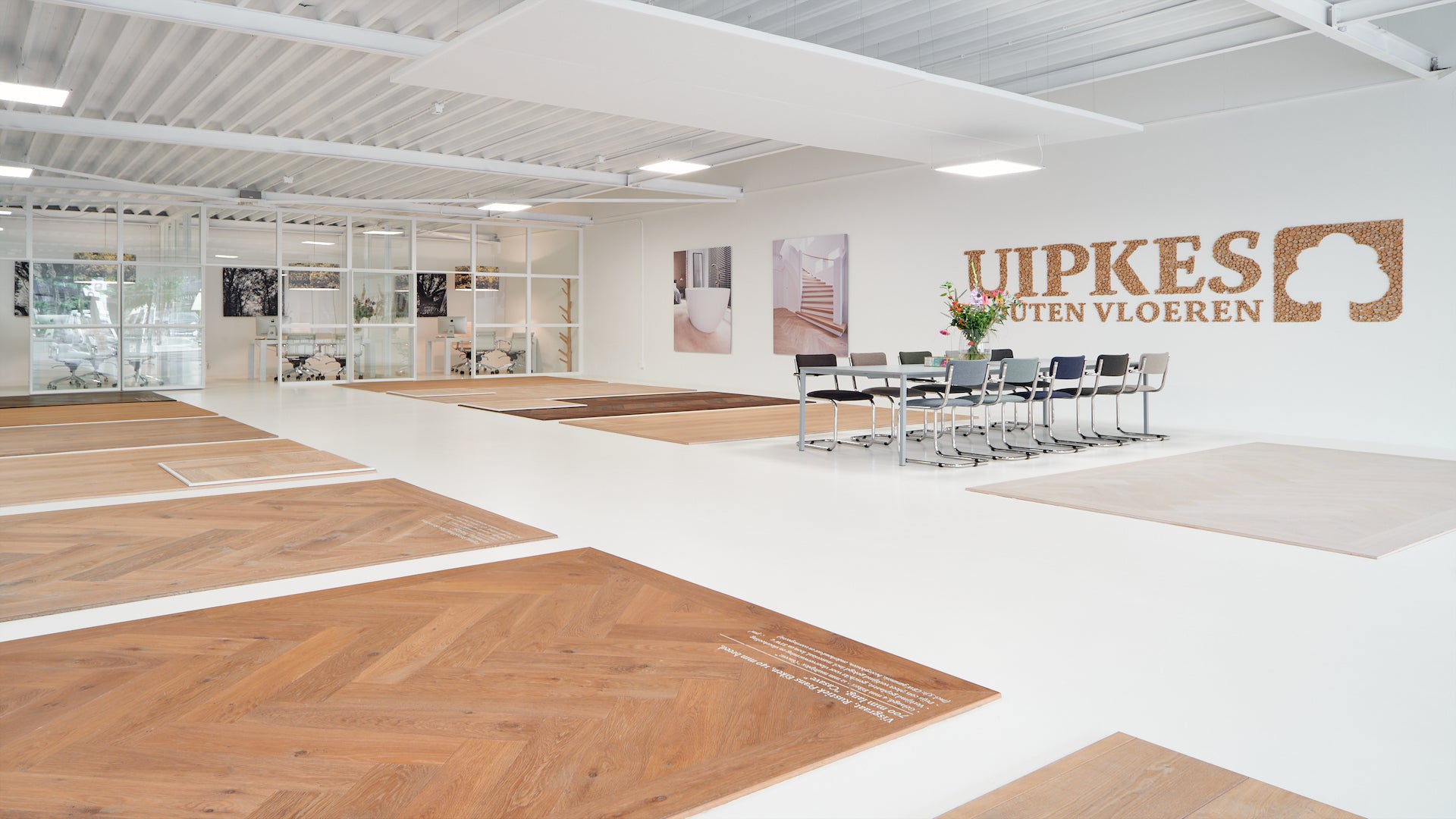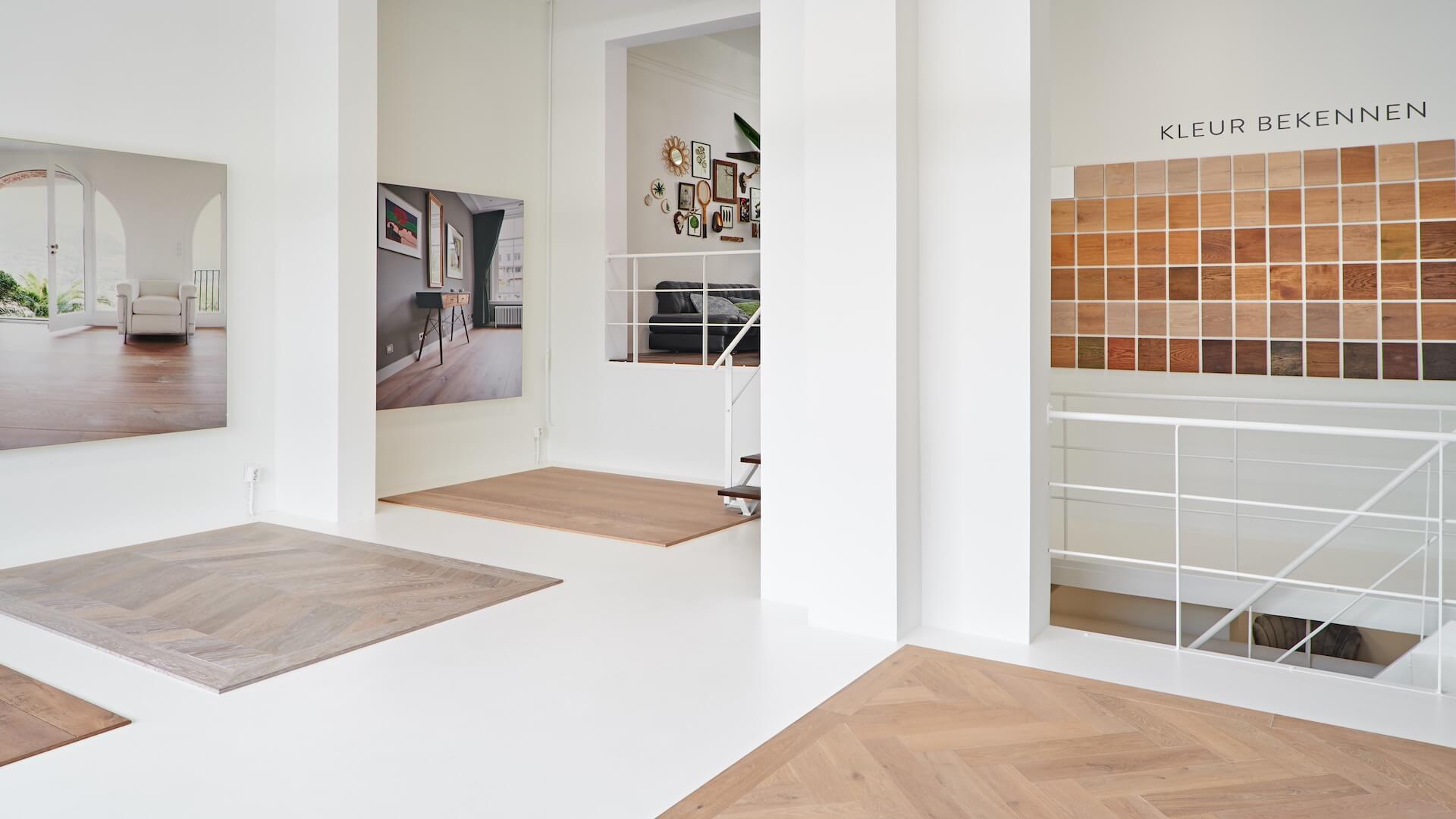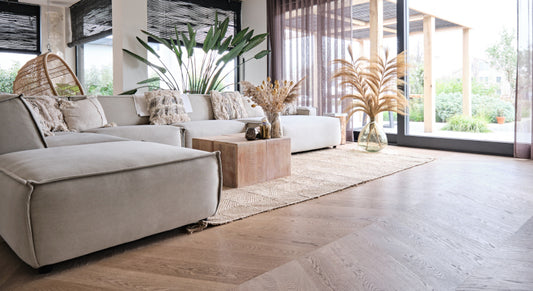Welke vloer op vloerverwarming

Datum: 21 november 2022
Leestijd: 4 minuten
Auteur: Uipkes Houten Vloeren
Do you want to install underfloor heating? In this blog we will tell you all about the possibilities.
Bezoek de showroom
Wooden floor on underfloor heating
Of all types of floors, a heated wooden floor feels the most pleasant and natural. Contrary to popular belief, a wooden floor in the form of oak engineered wood floor can be easily combined with underfloor heating .
Engineered wood flooring is a layered wooden floor where the top layer is made of solid oak . This means that the thermal resistance is low, allowing the heat to easily pass through the floor.
Advantages of a wooden floor over underfloor heating
- Of all floor types, wood feels the most natural.
- Wood cools relatively slowly, so it continues to emit heat for a long time.
- Engineered wood flooring has a bottom layer of cross-glued birch plywood. This layer hardly responds to temperature fluctuations and changes in humidity. Unlike laminate floors, you will hardly be bothered by the expansion and contraction of the floor. You can even install engineered wooden floors tightly against the wall, without skirting boards.
- Uipkes wooden floors are made of high quality sustainable European Oak. This means the floors can last a lifetime. You can repair any damage to the floor by having the floor sanded and oiled. And if desired, you can have the floor finished in a different color. This is useful if, for example, you have changed the interior style and the floor quality does not match the new style.
- Wood is a renewable raw material, making wooden floors a sustainable choice.
Magazine Vol inspiratie
Tiled floor on underfloor heating
Tiled floors can be combined well with underfloor heating and heat up relatively quickly. In addition, tiles have a low thermal resistance, which means that heat is effectively distributed to the room.
Although high-quality tiles do not wear out quickly, scratches and scuffs do occur over time. The only solution to make the floor look like new again is to replace the floor.
In the long term, a tiled floor is therefore more expensive than a wooden floor. Moreover, the raw materials from which tiles are made are not infinitely available. In terms of sustainability, a tiled floor is therefore not the best choice.
Thuis advies op maat?
Laminate on underfloor heating
Although laminate can be placed over underfloor heating , it is not the most suitable flooring type. Laminate can expand and contract considerably when there are large temperature differences in the home. Moreover, just like with tile floors, you cannot repair laminate if the floor is damaged.
PVC on underfloor heating
PVC floors are often used on underfloor heating and allow heat to pass through well. Moreover, maintenance is simple. Regular mopping is sufficient.
Unfortunately, there are a number of possible disadvantages to PVC floors. A PVC floor is made of polyvinyl chloride, or plastic. Several publications have appeared about the possible adverse effects of PVC on the environment and health.
We therefore prefer more sustainable floor types, such as wooden floors made from wood that comes from sustainably managed forests. At Uipkes we have consciously made the choice to specialize in this type of flooring.
Inspiratie & Informatie
Want to know more about underfloor heating ?
At Uipkes we have more than 25 years of experience in installing underfloor heating in combination with wooden floors. We can therefore advise you well and relieve you of your worries. After all, you only have one point of contact for your project.
Would you like to know more about the possibilities of wooden floors on underfloor heating ? Then visit one of our showrooms in Amsterdam or Alphen aan den Rijn.
Visit The Showroom
Frequently Asked Questions
Which floors are suitable for underfloor heating and what are the advantages and disadvantages per floor type?
Various floors can be used in combination with underfloor heating . Here are some pros and cons per floor type:
- Wooden floors: Wooden floors, such as parquet or engineered wooden floors, can work well with underfloor heating . Advantages are the natural appearance and heat conduction. However, wood is sensitive to fluctuations in humidity and temperature, which can lead to shrinking or expanding of the wood. It is important to choose the right wood specie suitable for underfloor heating and to keep an eye on humidity levels.
- PVC floors: PVC floors are suitable for underfloor heating due to their thermal conductivity and stability. They are available in various styles and patterns. PVC is easy to maintain. Disadvantages may include possible health risks and the fact that PVC has a less natural appearance than, for example, wood.
- Tiled floors: Tiles, such as ceramic or porcelain tiles, are excellent for underfloor heating . They conduct heat well and are very durable. Tiles are also easy to clean and available in various designs. A disadvantage may be that tiles can feel cold without underfloor heating in use.
- Natural stone floors: Natural stone, such as marble or granite, can be used in combination with underfloor heating . It conducts heat well and has a luxurious appearance. However, natural stone is more expensive than other floor types and requires regular maintenance.
Which floors are less suitable for underfloor heating ?
Not all floors are suitable for underfloor heating . Floors such as solid wood (not specifically designed for underfloor heating ), carpet and some laminate floors are less suitable due to problems with heat conduction and possible damage.
What are the sustainability considerations when choosing a floor for underfloor heating ?
When choosing a floor for underfloor heating , there are sustainability considerations to take into account:
- Durability of the material: Choose a flooring material that is durable and long lasting. Materials such as wood and tiles generally have good durability.
- Manufacturing process: Consider how sustainable the floor's manufacturing process is. Materials such as Wood can be more environmentally friendly if they are produced using recycled materials or renewable forests.
- Maintenance and lifespan: Take into account the maintenance the floor requires and its estimated lifespan. A floor that is easy to maintain and lasts a long time is generally more durable, such as tiles, natural stone and wood
How can I increase the sustainability of my underfloor heating system?
To increase the sustainability of an underfloor heating system, you can consider using an energy-efficient heat source, such as a heat pump. In addition, it is important to properly insulate the system to minimize heat loss. Regular maintenance and the use of an efficient thermostat can also contribute to the sustainable use of the underfloor heating system.
Is it possible to combine different floor types with underfloor heating ?
Yes, it is possible to combine different floor types with underfloor heating , such as a wooden floor in the living room and tiles in the bathroom. However, it is important to ensure good insulation and the correct heat output of the underfloor heating system for each floor type. It may be useful to seek advice from a professional to ensure that the combination of floor types works well with the underfloor heating system.
Stay up to date with news about floors and interior





